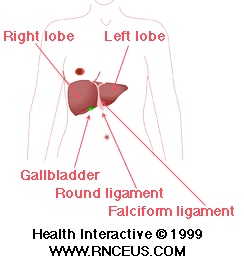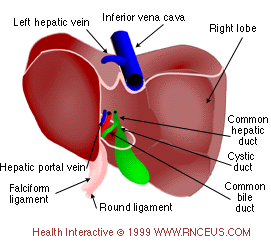
Primary functions of the liver
The liver is the largest organ in the body. It is located below the diaphragm in the right upper quadrant of the abdominal cavity. An adult's liver weighs approximately 3 pounds and extends approximately from the right 5th rib to the lower border of the rib cage.

The liver is separated into a right and left lobe, separated by the falciform ligament. The right lobe is much larger than the left lobe. The working cells of the liver are known as hepatocytes. Hepatocytes have a unique capacity to reproduce in response to liver injury. Liver regeneration can occur after surgical removal of a portion of the liver or after injuries that destroy parts of the liver. Although the liver's ability to react to damage and repair itself is remarkable, repetitive insults can produce liver failure and death.
The liver is a metabolically active organ responsible for many vital life functions. The primary functions of the liver are:
Due to these important activities, the liver is exposed to a number of insults and is one of the body's organs most subject to injury.
The biliary system consists of the
gallbladder, and the hepatic, cystic, and common bile ducts. The gallbladder is located
beneath the right lobe of the liver. The primary function of the
gallbladder is to store and concentrate bile. Bile is comprised
of bile salts, bilirubin, phospholipids, cholesterol, bicarbonate
and water. Bile salts mix with ingested fats to promote
absorption of fats from the gastrointestinal tract. Bilirubin,
cholesterol, and phospholipids are end products of metabolism.
Bicarbonate and water are needed in the gastrointestinal tract to
help neutralize stomach acid, as digestion and absorption require
an alkaline environment.
The gallbladder is located
beneath the right lobe of the liver. The primary function of the
gallbladder is to store and concentrate bile. Bile is comprised
of bile salts, bilirubin, phospholipids, cholesterol, bicarbonate
and water. Bile salts mix with ingested fats to promote
absorption of fats from the gastrointestinal tract. Bilirubin,
cholesterol, and phospholipids are end products of metabolism.
Bicarbonate and water are needed in the gastrointestinal tract to
help neutralize stomach acid, as digestion and absorption require
an alkaline environment.
After it's formation in the liver, bile flows into the hepatic duct. The hepatic duct joins with the cystic duct of the gallbladder to form the common bile duct, which then enters the duodenum at the ampulla of Vater. The sphincter of Oddi surrounds the ampulla of Vater.
When stomach contents, especially fats and protein enter the duodenum, cholecystokinin is released from the duodenal mucosal cells to stimulate contraction of the gallbladder and relaxation of the sphincter of Oddi so that bile can enter the small intestine.
Cholecystokinin also:
Instant Feedback: